The AMD Radeon R9 380X Review, Feat. ASUS STRIX
by Ryan Smith on November 23, 2015 8:30 AM EST- Posted in
- GPUs
- AMD
- Radeon
- Asus
- Radeon 300
Meet the ASUS STRIX R9 380X OC
For the launch of the Radeon R9 380X AMD sampled us with ASUS’s STRIX R9 380X OC. Arguably the highest-end of the R9 380X launch cards, the STRIX R9 380X OC comes with a factory overclock tied for the largest of any R9 380X and a further optional overclock for $259.
| Radeon R9 380X Cards | ||||
| ASUS STRIX R9 380X OC | Reference R9 380X | |||
| Boost Clock | 1030MHz / 1050MHz (GPUTweak OC) |
970MHz | ||
| Memory Clock | 5.7Gbps GDDR5 | 5.7Gbps GDDR5 | ||
| VRAM | 4GB | 4GB | ||
| Length | 10.75" | N/A | ||
| Width | Double Slot | N/A | ||
| Cooler Type | Open Air | N/A | ||
| Price | $259 | $229 | ||
The STRIX R9 380X is the latest entry in ASUS’s popular STRIX family of cards. At one point STRIX was ASUS’s brand for upscale video cards, occupying a slot between their standard cards and their high-end Republic of Gamers cards, but at this point with the majority of ASUS’s cards falling under the STRIX branding, it arguably has transformed into what is their de facto mainstream lineup of video cards.
The STRIX R9 380X OC ships at 1030MHz for the core clock, a 60MHz (6%) boost over the reference R9 380X. On top of that ASUS offers a pre-programmed 1050MHz mode via their GPU Tweak software, though a further 20MHz overclock is going to be pretty small in the long-run. Otherwise ASUS only touches the GPU clockspeed, leaving the memory clock at AMD’s default of 5.7Gbps. Out of the box, the STRIX R9 380X OC is going to be around 4% faster than a reference R9 380X card.
Like the other STRIX cards we’ve looked at this year, ASUS has been focusing on workmanship and a common visual theme for these cards. The STRIX R9 380X OC features a version of one of ASUS’s DirectCU II coolers, combining an oversized fan assembly with a 3 heatpipe heatsink assembly. The fan assembly in turn uses a pair of the company’s “wing-blade” fans, each measuring 94mm in diameter and giving the fan assembly its overall large size.
As is usually the case on ASUS cards, the STRIX R9 380X OC implements ASUS’s variation of zero fan speed idle technology, which the company calls 0dB Fan technology. While ASUS is no longer the only partner shipping zero fan speed idle cards, they are still one of the most consistent users of the technology, and surprisingly we still don’t see this in every open air card released on the market.
Sitting below the fan assembly, the DirectCU heatsink being used in ASUS’s 380X card is a typical tri-pipe configuration. The aluminum heatsink runs virtually the entire length of the card – and past the PCB – with a pair of 8mm heatpipes and a 10mm heatpipe providing additional heat transfer between the Tonga GPU and the rest of the heatsink. ASUS’s design doesn’t make contact with anything other than the GPU – so the GDDR5 RAM chips sit uncovered – with the airflow coming through the heatsink being sufficient to cool those chips.
Moving on to the PCB, ASUS has implemented their standard Super Alloy family of MOSFETs, capacitors, and chokes. ASUS uses an 8 phase VRM system here, taking advantage of the already oversized fan assembly to allow them to use a slightly taller than normal PCB to fit all of the power phases.
Flipping over to the back side of the card, we find a full-size backplate running the length of the card. There are no critical components on the back of the card, so while the backplate doesn’t provide any cooling it does serve to protect the card and reinforce it against bending. To that end a small lip extends past the backplate and meets up with the heatsink, preventing the heatsink from flexing towards the board. Small details such as these are why the STRIX cards have consistently been the most solid of the custom cards to make it through our hands this year, as the card is well-supported and isn't free to warp or bend.
Looking at the back we can also see the two 6-pin power connectors used to supply additional power to the card, along with the red and white power LEDs for each connector. Like some of their other cards, ASUS has flipped the PCIe power connectors so that the clip is on the back side of the card, keeping the clip clear of the heatsink and making it easier to plug and unplug the card. On a side note, I suspect this will be one of the last cards we review with two 6-pin connectors rather than a single 8-pin connector. Though electrically equivalent (150W), we’re already seeing cards like the R9 Nano shipping with the single 8-pin connector, and dual 6-pin connector cards will become increasingly rare.
As for Display I/O, ASUS is using a rather typical 1x DL-DVI-I, 1x DL-DVI-D, 1x DisplayPort, 1x HDMI port configuration. Multiple DVI ports, though not in any way petite, have been a common fixture on sub-$250 cards this generation and will likely remain that way for some time to come due to slower adoption of newer display I/O standards in the APAC market, which only recently has finally seen analog VGA phased out.
Finally, on the software front, the STRIX R9 380X OC includes ASUS’s GPU Tweak II software. The software hasn’t significantly changed since we last looked at it in July, offering the basic overclocking and monitoring functions one would expect from a good overclocking software package. GPU Tweak II allows control over clockspeeds, fan speeds, and power targets, while also monitoring all of these features and more.
Wrapping things up, as briefly mentioned earlier the STRIX R9 380X OC is the most expensive of the R9 380X launch cards. ASUS is charging a $30 premium for the card over AMD’s reference MSRP, putting the price at $259. Premium, factory overclocked cards aren’t anything new, but it does mean ASUS is in a bit of a precarious spot since the much more powerful Radeon R9 390 cards start at $289, meaning the premium price further amplifies the spoiler effect of the R9 390.


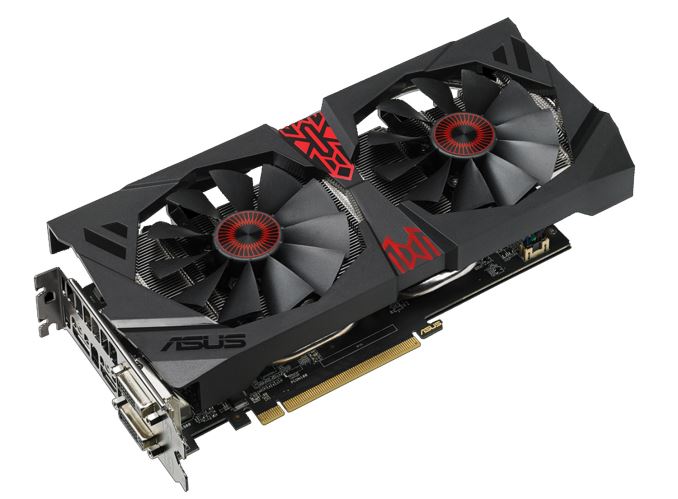
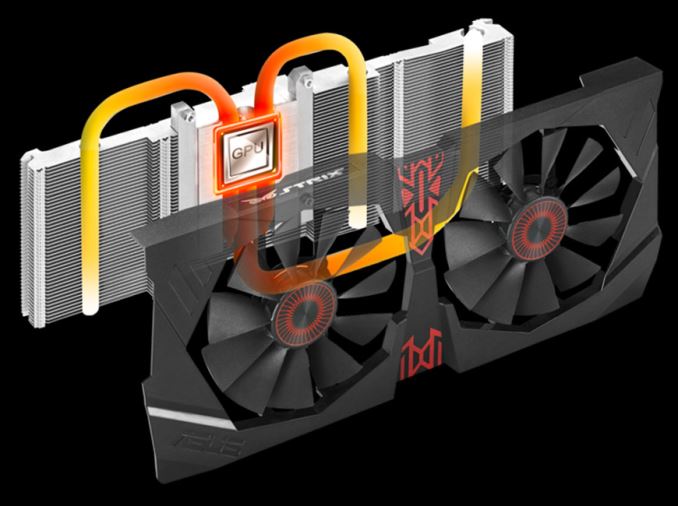
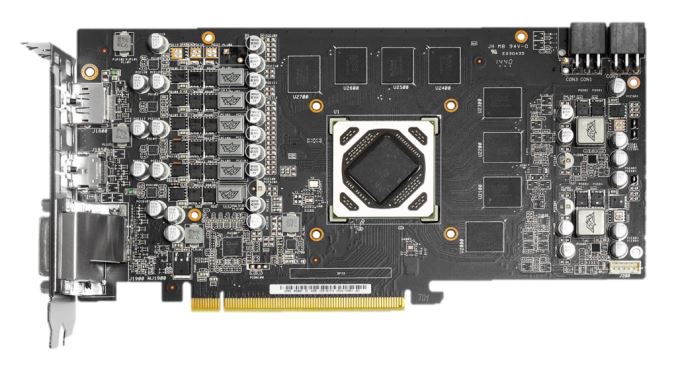
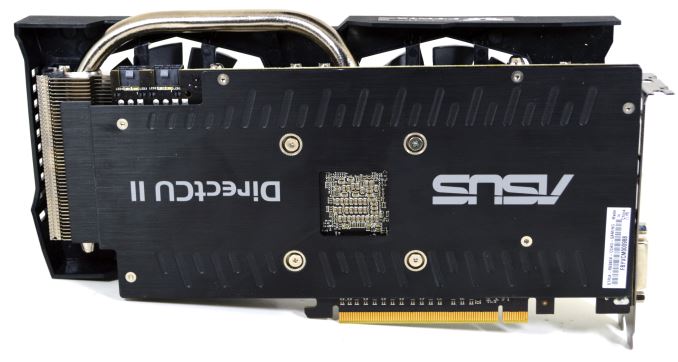

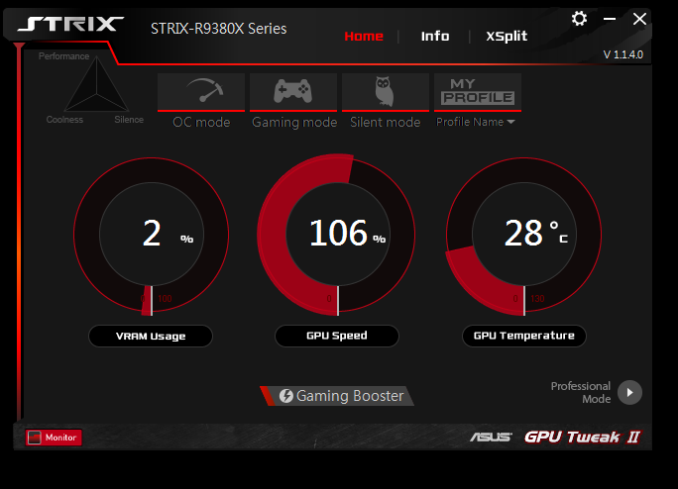








101 Comments
View All Comments
Samus - Monday, November 23, 2015 - link
I had the Asus GTX970 Turbo and it had the grindiest ball bearing fan I've ever heard. It brought me back to the Athlon's YS Tech and Delta days. The "Titan" cooler on my old GTX770 was virtually silent in comparison.So Asus has their duds, but the Strix seems to be a great cooler if you don't need a blower...but many of us do. In a bit a shame toward Asus, I replaced their Turbo with a PNY 970 (also a blower) and the PNY feels cheaper, but cools better and makes less noise.
evilspoons - Tuesday, November 24, 2015 - link
Don't get me wrong here, I really like ASUS stuff - but they have let me down several times on cheapo video card cooling systems. Nasty sleeve bearing fans on half-height Radeon 6580s that vibrate then seize, which was really cheeky considering the box had a "high quality fan omg!!" thing as part of its marketing material.Ended up replacing the half-height card with a passively cooled one - and a nearby 80 mm case fan - so I couldn't have a crappy onboard fan, since every other card on the market seemed to be carrying the same stupid POS fan. I couldn't even spend more to get a better one!
Margalus - Monday, November 23, 2015 - link
I wouldn't get anything other than a EVGA cooling system.. I have the ACX 2.0 verions of a 970 and a 980 ti, and they are really fantastic... lolSamus - Tuesday, November 24, 2015 - link
EVGA is great, but they don't make Radeon cards. It's important to point out, as well, that EVGA is actually NOT NVidia's OEM partner. PNY is. PNY makes a ton of cards based off NVidia's reference designs, which I think are the best. The Titan cooler used on reference 770/780/970/980 GPU's, specifically the vapor-chamber variant, is unsurpassed by any other partners'. That's why almost every partner makes at least one variant of these GPU's with the Titan cooler. They don't make many, because the rumor is NVidia charges $30 for the vapor chamber cooler and it is more expensive to manufacture the cards because of the installation (GPU binding) technique.But EVGA has probably the best, easiest to deal with warranty. Unfortunately I've had to use it.
tamalero - Tuesday, November 24, 2015 - link
If use Sapphire's DualX and triX for the AMD camp imho.I'm still with my trusty 7950 dual X OC. and works wonders!
just4U - Friday, November 27, 2015 - link
From what I understand Sapphire started with the vapor chamber type cards on a few of their Radeons 6 years ago.. Interesting that Nvidia went that route. I'd never heard of any other company doing it before and didn't know they had that on their high end coolers..maecenas - Monday, November 23, 2015 - link
Fair enough, I am generalizing based on an observation pool of 2, which I shouldn't do, but I really enjoy having a silent GPU that doesn't go over 65C! It seems that cooling technology has progressed across the board, which is great news for everyone.BurntMyBacon - Tuesday, November 24, 2015 - link
@maecenasI agree they have a nice cooling system. They may even have the best at the moment. That said, I do believe they have some good competition in this area. MSI impressed me with their Twin Frozer design back before Asus had a DirectCU design out. They've been constantly improving since then. Saphire (much as I dislike them) released some very appealing vapor chamber designs. EVGA had pretty decent blower coolers, but nothing really standout until their second revision of their non-blower design (ACX 2.0). The ACX 2.0+ is copper heaven. I don't really favor designs that just throw another fan at it without really giving much thought to the heatsink design like Gigabyte's Windforce cards. I feel like MSI set the bar with their original Twin Frozer cards and since then, MSI, Asus, Saphire (sigh), and now EVGA have been vying for dominance in the cooling department.
just4U - Friday, November 27, 2015 - link
Strix is nice but MSI's cooling solution is just as good.olivaw - Monday, November 23, 2015 - link
Did I miss the GTX 960 review???